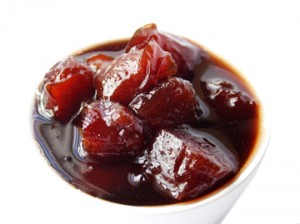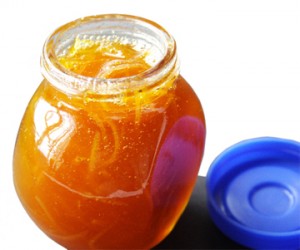Jam versus jelly versus marmalade
Hi Everyone,
“Would you please pass the jelly?” Remember that line from one of the old Polander All-Fruit commercials? The one where a sophisticated, wealthy family is gathered for a meal and as the bottle of fruit spread is passed around you hear them say, “pass the all-fruit; pass the Polander-All Fruit” and then there is this visitor sitting at the table and given his accent and the expression on his face, it is clear that he is supposed to be a simple man with an unsophisticated upbringing; he simply says, “Would you please pass the jelly?” at this, the matriarch almost passes out with shock that such an ordinary name should be ascribed to their oh-so-pure and refined fruit spread. The announcer’s voice then says, “You’ll call it delicious, you’ll call it remarkable but please, don’t dare call it jelly.”
In the United States of America, jam and jelly refer to the same thing and the words are used interchangeably, however, in some other countries, like Canada, the United Kingdom and Australia, jam is different from jelly and so too is marmalade.

There are so many things that we eat and use daily and just take for granted, never stopping to find out more about them or why they’re called certain names. I think that jam, jelly and marmalade fall into that category. Recently, while visiting a friend, I noticed that she had a bottle of marmalade in the refrigerator but that she hardly used it though she had toast daily. When I enquired, she said, “it is not marmalade, it is too sweet.”
I have never been a fan of marmalade for the exact reason that it is marmalade – there is an element of a bitter tang. I then realized my friend’s objection to the marmalade in her fridge – it was American-style marmalade which is sweet throughout. My friend is British-born so of course, she would prefer the British-style marmalade with the bitterness to which she is accustomed. Personally, I prefer jams, jellies do nothing for me; I like the heightened fruitiness and pulp I get in a jam.
In its simplest form, jam is fruit that is preserved for long-term storage and usage. There are however, many variations of the fruit preservation and some are preferred over others for a variety of reasons. Each has its own particular use and method of preparation. For the purpose of this column, I want to look primarily at jam, jelly and marmalade.
Jam is made with fruit that is mashed or chopped and boiled with water and sugar. Here in the Caribbean we often add sweet spices such as cinnamon, cloves, or all-spice berries to brighten and heighten the flavours of the fruits when making jam. The mixture is boiled until thickened. If you want to get scientific, when the temperature reaches 219 degrees Fahrenheit it means that the jam is ready. At that degree of heat, the acid and pectin from the fruit juices have reacted adequately with the sugar and the jam will set upon cooling. Most people like me however, prepare jam by trial and error. In other words, we let our eyes do most of the work, watching to see when the mixture’s at a rolling boil and then starting to change its texture and the bubbles get glossy and thick. Others go beyond the stage of watching by dropping samples onto a plate to see if the jam would run or set when cool.
Some fruits, it should be noted, set into jam much more easily than others and that is because of the fruits’ pectin – pectin is an extract from citrus fruits that aids in the gelling process in jams and jellies. Pineapples, guavas and apples make excellent jam because of their high pectin content. Because some fruits such as strawberries do not have high pectin content, the gelling process is aided by adding commercially produced pectin which is a white to light brown powder. It is usually found in the baking section of most supermarkets.

Jam should have a soft, spreadable consistency. Some jam aficionados would tell you that “good jam” should have no distinct pieces of fruit in it. I don’t mind the jam with soft pieces of fruit, I like the texture and to me it makes the jam even richer and fruitier.
Jelly is a type of clear fruit spread; it is made from the juice of the fruit, sugar and pectin. Unlike the jam, it is necessary to add pectin when making jelly as you are only using the juice of the fruit and while the juice would contain some pectin, it would not be enough to give the gel-texture to the jelly.
To make fruit jelly you start by chopping the fruit and cooking it with water until it is very soft. Once cooked, the fruit and its juices then need to be strained. It should be strained using multiple layers of cheese cloth, a new clean piece of cotton fabric soaked in cold water or, if you have one, a jelly bag. The straining device with the pulp and juices should be suspended over a bowl that catches the juice. You can tie the ends of the cloth and suspend it over a bowl in the sink letting your faucet act as the hanging bar. It should be left to drip by itself until all the juice is extracted. If you choose to squeeze the juice then you can end up getting cloudy juice hence cloudy jelly but hey, if you don’t mind, it’s not a problem.
To make the jelly, pectin is stirred into the juice and brought to a boil on high heat, the sugar added, stirred and the mixture brought to a roaring boil for about 1 minute, removed from the heat, the froth skimmed and the jelly is poured into sterilized jars and cooled. Good jelly is said to be tender enough to quiver when moved but firm enough to hold angles when cut.
Marmalade (I’m talking here about the British-style marmalade) is traditionally made with citrus fruits such as limes, lemons, grapefruits and oranges with orange being the most popular. To make marmalade, the sliced or chopped fruit peel along with the pureed pulp and juice of the fruit that have been sieved, are cooked with sugar and water. It is cooked just like jam and should carry the same characteristics such as being soft and easily spreadable. The taste however should be complex with the requisite notes of bitterness at the end and bright fruitiness.
So there you have it, the difference between what we know as jam, jelly and marmalade.
Cynthia
[email protected]
www.tasteslikehome.org

